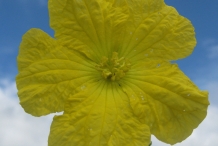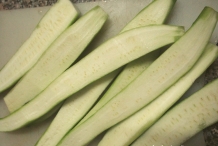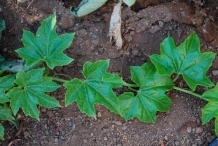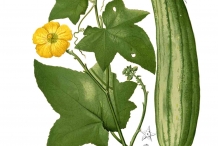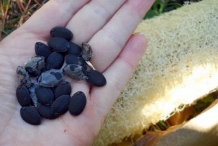Plant
Luffa grows best in tropical and subtropical climates and thrives in well-drained soils. It is a coarse, vigorous, monoecious and annual vine that bears cylindrical and smooth fruits which are used as culinary vegetables. It grows on bushy plants that are 30 ft. (9 m) long. The plant has got five angled stems. The leaves are dark green, ovate-reinform with silvery patches topside. The flowers are monoecious, yellow having the diameter of 5-7.5 cm. The plant bears flowers during summer. There are three varieties of Luffa such as: Angled luffa, Smooth luffa, Taiwan luffa.
Fruit
Luffa fruit is smoothly cylindrical and about 24 inch (61 cm) in length and 3 inch (7.6 cm) in diameter. In general, the fruit features thin and smooth green skin, white flesh and smooth, black, flat ovate seeds with length 1-12 cm. concentrated near its core. The taste of the fruit resembles zucchinis.
Nutrition
Luffa fruit (Sponge Gourd) contains various antioxidants, minerals, vitamins, nutrients and lipids. It is an excellent source of Vitamin A and carbohydrates. It is also a very good source of Vitamin B5, Manganese, Potassium, Copper, Total dietary fiber, Vitamin B6, Vitamin C and Magnesium.
Health Benefits of Sponge gourd
All parts of the Luffa plant possess the medicinal properties. Luffa Fruit (Towel Gourd) is used in cooking as well as to treat various health ailments. It is helpful to lower the blood sugar, constipation, weight loss, and hypoglycemia, enhance immune system, weight loss and detoxifies the body.
- Prevents eye ailments
Vitamin A prevents from the macular degeneration that leads to the blindness. The study conducted by the National Eye Institute shows that those who took vitamin C, vitamin A, copper, vitamin E and zinc, their chances of macular degeneration was decreased by 25% in a six year period. The study also shows that the eye drops of Vitamin A effectively treat the dry eyes. Including Vitamin A rich food Luffa fruit in your daily diet may help to reduce eye ailments.
- Cardiovascular benefits
Vitamin B5 in 900 mg dose helps to reduce the bad cholesterol as well as triglycerides which reduce the chances of cardiovascular disease. As 900 mg dosage is the higher amount, one should consult the physician before taking.
- Prevent diabetes
Manganese is essential for the production of digestive enzymes which is responsible for a process called gluconeogenesis. The research conducted by the Department of Internal Medicine and Biochemistry showed that mice that were given the manganese, their glucose tolerance were improved in 12 weeks. The manganese promoted the secretion of insulin, reduce the lipid peroxidation and enhance the mitochondrial function.
4. Prevents muscle pain
Potassium balances the fluid levels and helps to relax muscles. The low presence of potassium leads to the muscle cramps, spasms and pain. It assists to break down the protein and carbs on which the muscle depends for the repair and energy.
- Reduce arthritis
Copper provides anti-inflammatory properties which soothe stiffness and pain which is related to arthritis. It is able to assist with muscular strength, repair connective tissue. The people with arthritis wear copper bands or bracelets as it is believed that the copper can reduce the painful symptoms.
- Treat Anemia
Vitamin B6 is essential to produce hemoglobin in the blood which helps to transport the oxygen to the cells and mobilizes iron. Anemia is the result of inadequate red blood cells. The patients of anemia might experience these symptoms such as aches, fatigue and pain. The study shows that the consumption of Vitamin B6 in adequate amount reduces the symptoms of anemia and prevents its occurring.
- Skin health
The study shows that high intake of Vitamin C can reduce the skin dryness, wrinkles and slows down the aging process. Vitamin C is essential for the production of protein to form tendons, skin, blood vessels and ligaments. It assists in the healing process of wound and also forms a scar tissue.
- Migraine headaches
The inadequate amount of magnesium is related to migraine headaches. Magnesium assists to balance the neurotransmitters in the body. The study which was published in Expert Review of Neurotherapeutics showed that the dose of 300 milligrams of magnesium lowers the recurrence of migraine headaches.
- Brain function
Oxygen is required for the brain to function properly. The brain results to poor memory, apathy and decrease productivity in the absence of iron as the brain won’t receive oxygen. The deficiency of iron leads to restless, irritation and inattentive.
10. Type 2 diabetes
The food rich in magnesium helps to reduce the chances of type 2 diabetes because magnesium is essential for glucose metabolism. The dose of 100 milligrams of magnesium in a day reduces the chances of diabetes by 15 percent.
Traditional uses
Various parts of the plant are used in the folkloric ethnomedicine. It is believed that Luffa Fruit is pectoral, carminative, anthelmintic, cooling to the blood; facilitate circulation, antiseptic, emmenagogue and galactagogue. The fruit is used as a tonic to the genital organs, beneficial to the intestines, demulcent and cooling or warming to the stomach. The dried fruit is used as an emetic after steeped. In Java, juice of the leaf is used to cure amenorrhea whereas, the people of India is used to treat snake bites and dysentery. In Philippines, the skin diseases and orchitis are treated by using the leaves. The seeds are used as cathartic, emetic and hydragogue. The infusion made from the seeds is used as an anthelmintic drastic and purgative. The extracts of root and vine are helpful for tooth decay, ozoena and parasitic affections. The extract from leaves helps to induce labor during childbirths in Western Uganda.
How to eat
The buds, flowers and young fruits are consumed as okra or squash after cooking. Luffa fruit could be either sautéed in a little oil or sliced in a stir fry. The flowers could be added to the salads. In stir-fried dishes and soups, Luffa Fruit could be added as an ingredient. The skin could be used to make chutneys. It could be stir fried or used in curry as a vegetable.
Precautions
Pregnant and breast feeding women should consume it in food amounts and the excessive intake of Luffa Fruit should be avoided.
Comments
comments
| Luffa Fruit Quick Facts | |
|---|---|
| Name: | Luffa Fruit |
| Scientific Name: | Luffa aegyptiaca |
| Origin | Tropical Africa and Asia but now grown throughout Asia and the United States for food and scrubbers. |
| Colors | Green |
| Shapes | Cylindrical, smooth, Length: 61 cm, Diameter: 7.6 cm |
| Flesh colors | White |
| Taste | Resemble zucchinis |
| Calories | 100 Kcal./cup |
| Major nutrients | Vitamin A (66.14%) Carbohydrate (19.64%) Vitamin B (17.84%) Manganese (17.26%) Potassium (17.15%) |
| Health benefits | Reduce arthritis, Treat Anemia, Skin health, Prevent diabetes, Brain function |
| More facts about Luffa Fruit | |

